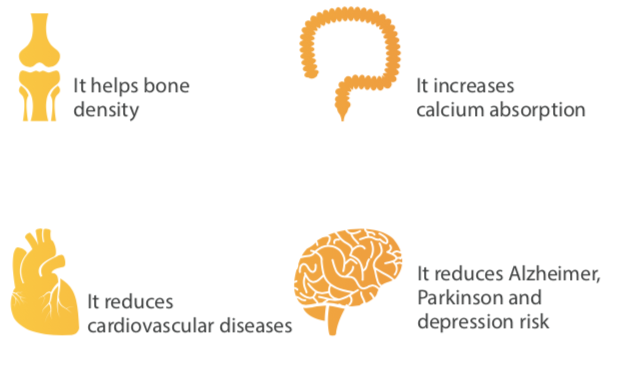EuTylia D3 drops
- How to use
EuTylia D3 gocce
EuTylia D3 drops can be administered on a monthly basis, 10 ml (25,000 IU), or as prescribed by a medical professional.
EuTylia D3 tablets
EuTylia D3 orodispersible tablets can be prescribed daily, weekly, monthly or annually according medical prescription. One tablet per day.


- Risk factors
The risk factors of hypovitaminosis D:
- Poor sun exposure
- Intense skin pigmentation
- Inadequate food intake
- Granulomatous diseases (tuberculosis)
- Increased requirements (kidney disease, liver failure, use of anticonvulsant drugs,
pregnancy) - Gastrointestinal disease (intestinal malabsorption syndromes, cystic fibrosis, Crohn’s disease, celiac disease, gastric bypass)
- Obesity
- Smoking
- Active ingredients
| Active ingredients | EuTylia D3 tablets | EuTylia D3 drops |
|---|---|---|
| Q.ty per tablet | Q.ty per 0,5ml | |
| Vitamin D3 (cholecalciferol) | 2000 unity (50 mcg) | 1250 unity (31,25 mcg) |
Vitamin D is available in two forms:
- cholecalciferol (vitamin D3), which is synthesized in the skin by ultraviolet irradiation starting from 7-dehydrocholesterol, but it can also be introduced with animal fats (fish liver, milk, eggs, meat);
- ergocalciferol (vitamin D2), derived, due to the effect of ultraviolet irradiation, from ergosterol introduced by the diet (yeast).
Both are activated first by the liver, then by the kidney to form calcitriol, the active vitamin.
Normal levels range from 30 to 100 ng / mL. Below 20 ng / mL the deficiency is moderate, below 10 ng it is severe.
Vitamin D is a fat-soluble organic compound, similar in chemical structure to steroid hormones, deputed to cover important functions in the human body, including promoting the absorption of calcium in the intestine; to keep blood calcium and phosphorus levels normally; to promote the reabsorption of calcium and phosphorus in the kidneys; to strengthen bones, by the deposition of calcium in the bone tissue. It also seems that vitamin D is involved in important protection mechanisms against chronic extraskeletal diseases such as various types of cancer (breast and colon), diabetes, cardiovascular diseases, autoimmune diseases. Symptomatic hypovitaminosis D can also cause bone and joint pain, muscle weakness, muscle binding, brittle bones (which tends to deform in young people or break easily in adults), depression of mood and mental fatigue.
Numerous scientific evidences confirm the importance of vitamin D, not only in bone metabolism, but also in the modulation of immune competence, muscle metabolism, reduction of cancer risk and optimization of the course of pregnancy.
- Why EuTylia D3 drops?
The vitamin D3 functions are numerous.
It protects bone health, activating osteoblasts and reducing osteoclast activity, thus it reduces the risk of osteopenia and osteoporosis, even more if synergized with adequate physical movement and a diet rich in calcium, magnesium and vitamin K. It protects the muscle health, preventing the destruction of muscle contractile proteins and improving the peripheral use of insulin, especially in the muscle level. It enhances the competence of the immune system: its deficiency, actually, increases the susceptibility to respiratory infections, inflammatory and autoimmune diseases. It improves cardiovascular health, with a primary anti-inflammatory action on the endothelium and with indirect actions through the reduction of diabetes and hypertension.
Recent studies in the literature have shown a regulatory role of vitamin D3 in ovarian steroidogenesis of granulosa cells, suggesting that its supplementation could have beneficial effects on improving the quality of development and follicular maturation in women suffering from polycystic ovary syndrome.
Furthermore, vitamin D has a protective and regenerative action on the central, peripheral and visceral nervous system. It helps brain development since the moment of conception, protects nerve cells and reduces brain inflammation. It is essential in pregnancy for fetal brain development. After birth, it protects the quality of sleep, helps to modulate mood and reduces Alzheimer and Parkinson risk (often associated with osteoporosis). In pregnant women, vitamin D deficiency is associated with impaired glucose homeostasis, increased risk of bacterial vaginosis and unfavorable obstetric and perinatal outcomes such as gestational diabetes mellitus, pre-eclampsia and fetal growth retardation.
Vitamin D3 acts as a transcription factor of DNA genes and influences the cardinal mechanisms of tumor formation: growth, cellular differentiation and angiogenesis necessary to nurture growth and aggression. Recent studies show a protective effect of vitamin D3 on cancer risk, especially in breast and colorectal cancers.


- Bibliography
- Nahas-Neto J, Cangussu LM, Orsatti CL, Bueloni-Dias FN, Poloni PF, Schmitt EB, Nahas EAP. Effect of isolated vitamin D supplementation on bone turnover markers in younger postmenopausal women: a randomized, double-blind, placebo-controlled trial. Osteoporos Int. 2018 May;29(5):1125-1133
- Bakhshalizadeh S, Amidi F, Alleyassin A, Soleimani M, Shirazi R, Shabani Nashtaei M. Modulation of steroidogenesis by vitamin D3 in granulosa cells of the mouse model of polycystic ovarian syndrome. Syst Biol Reprod Med. 2017 Jun;63(3):150-161
- Wei SQ .Vitamin D and pregnancy outcomes. Curr Opin Obstet Gynecol. 2014 Dec;26(6):438-47
- Lappe J, Watson P, Travers-Gustafson D, Recker R, Garland C, Gorham E, Baggerly K, McDonnell SL.Effect of Vitamin D and Calcium Supplementation on Cancer Incidence in Older Women: A Randomized Clinical Trial. JAMA. 2017 Mar 28;317(12):1234-1243
- Gugger A, Marzel A, Orav EJ, Willett WC, Dawson-Hughes B, Theiler R, Freystätter G, Egli A, Bischoff-Ferrari HA. Effect of Monthly High-Dose Vitamin D on Mental Health in Older Adults: Secondary Analysis of a RCT. J Am Geriatr Soc. 2019 Feb 1
- Pilz S, Trummer C, Pandis M, Schwetz V, Aberer F, Grübler M, Verheyen N, Tomaschitz A, März W. Vitamin D: Current Guidelines and Future Outlook. Anticancer Res. 2018 Feb;38(2):1145-1151
- Jakovac H. COVID-19 and Vitamin D-Is There a Link and an Opportunity for Intervention? Am J Physiol Endocrinol Metab 2020 May 1; 31 (8): E589 doi: 1152/ajpendo.00138.2020.
- D’Avolio A. et al. 25-Hydroxyvitamin D Concentrations Are Lower in Patients With Positive PCR for SARS-CoV-2. Nutrients. 2020 May 9;12(5):E1359.doi: 10.3390/nu12051359.
- Kara M. et al. ‘Scientific Strabismus’ or Two Related Pandemics: COVID-19 & Vitamin D Deficiency. Br J Nutr. 2020 May 12; 1-20. doi: 10.1017/S0007114520001749. Online ahead of print.
- Ebadi M. et. al. Perspective: Improving Vitamin D Status in the Management of COVID-19.J Clin Nutr. 2020 May 12;1-4.doi: 10.1038/s41430-020-0661-0.
- Ilie C et. al. The Role of Vitamin D in the Prevention of Coronavirus Disease 2019 Infection and Mortality. Aging Clin Exp Res. 2020 May 6;1-4.doi: 10.1007/s40520-020-01570-8.Online ahead of print.
- Mollo Ej et al. Vitamin D, Covid-19 and Children. Ir Med J. 2020 Apr 3;113(4):64
- Grant E et. al. Evidence That Vitamin D Supplementation Could Reduce Risk of Influenza and COVID-19 Infections and Deaths. Nutrients.2020 Apr 2;12(4):988.doi: 10.3390/nu12040988.
